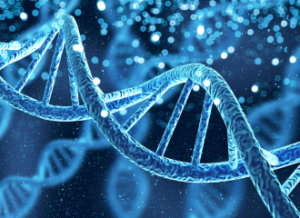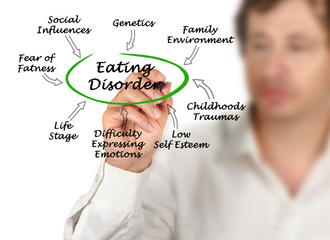Written by: By Samantha DeCaro, PsyD (she/her)
Director of Clinical Outreach and Education
Are eating disorders genetic? If you have a family history of EDs, are you or your children at greater risk for developing one? If so, what can you do about it? In this post, we examine the genetic and environmental factors at play and offer 10 tips to help stay ahead of both.
Are Eating Disorders Caused by Genetics or the Environment?

Genes are not the only factor at play. Numerous environmental and experiential factors can increase someone’s risk of developing an eating disorder and must be present to turn those genes on or off. It can be helpful to think of your DNA like a piano – there are many piano keys, but each key must be pressed down by something in the environment to produce a sound. The presence of sociocultural, biological, psychological, and developmental factors can all press on those piano keys.
Did I Cause an Eating Disorder?
Many people blame themselves for having an eating disorder or believe they have caused someone else to develop one. Feelings of shame and guilt not only fuel eating disorder cycles, but also rattle the confidence and composure needed to support a loved one in recovery.
Currently, there is no known cause that is both necessary and sufficient for the development of an eating disorder. Understanding the highly complex interaction of genetics, environment, stressful experiences, and protective factors can potentially reduce shame and guilt and improve patience and compassion in the recovery process. Recognizing the powerful role of the environment can also motivate and empower families and supports to take accountability, repair mistakes, and reduce as many environmental risk factors as possible.
Using the “Jar Model” to Understand Eating Disorder Risk
To better understand how genetics, environment, and protective factors affect eating disorder risk, the “Jar Model” can be a helpful visual analogy (found at NSGC.org). We all have a “jar” for mental illness, including one for eating disorders. Our eating disorder jar must be filled all the way to the top with genetic and environmental “marbles” to actively experience an eating disorder diagnosis.
Imagine there are red marbles that represent our genes. There are people with more red marbles in their jar than others depending on their biology and their family history. Maybe the red marbles fill your jar halfway or maybe there are only a few rolling around at the bottom. Now imagine there are yellow marbles that represent the environmental factors and stressful experiences we collect over our lifetimes. For example, dieting is one of the biggest risk factors that will add yellow marbles to the jar. Stressful experiences such as trauma, life transitions, food insecurity, or weight discrimination might move the level of marbles even closer to the brim. When the red and yellow marbles finally hit the top, that’s when an eating disorder emerges.
We may not have much control over the marbles we’re given, but the good news is that we have the amazing ability to increase the size of our jar. By stacking “rings” on the top, we can make our jar much taller. The taller our jar becomes, the more marbles it can hold without ever filling up. These protective “rings” might include managing stress, prioritizing sleep, eating intuitively, building a supportive network, going to therapy, practicing body neutrality, or engaging in joyful movement. These individualized strategies and coping skills create much more room for the marbles already inside.
What Should I Do If Eating Disorders Run in My Family? 10 Tips
If you have a family history of eating disorders, don’t panic. You, your child, or your future child are not destined to develop an eating disorder simply because of genetics. There are many ways to add on “rings” to an eating disorder jar. Here are 10 ways to reduce risk, support mental health and help foster a healthier relationship with food and the body before, during, or after an eating disorder develops.
Tip #1: Don’t Diet
Do not diet in front of children or encourage a child to diet. It’s estimated that 20-25% of dieters will go on to develop a clinical eating disorder, the 2nd deadliest psychiatric condition in the DSM-5. Dieting and restricting can potentially damage your relationship with food for years to come.
Tip #2: Embrace Body Diversity
Bodies come in all shapes and sizes and all bodies are equally deserving of respect and care. Learn these concepts and teach these concepts to children.
Tip #3: All Foods Fit
Food is more than fuel. Avoid labeling it as “good” or “bad” and allow food to be a source of pleasure, culture, celebration, comfort, and connection without shame or guilt attached to it. Consider the various benefits of intuitive eating by reading the research on this approach to nutrition. (Link: https://pubmed.ncbi.nlm.nih.gov/?term=intuitive+eating&filter=ds1.y_10)
Tip #4: Reject Diet Culture
Redefine your definition of ‘health’ and unlearn the harmful diet culture myths that thin bodies are always healthy and larger bodies are always unhealthy. Rather than using weight as a measure of wellness, encourage and model health-promoting behaviors without intentionally pursuing weight loss.
Tip #5: Shift the Focus
Focus less on appearance and more on interests, personality, and core values. Identify your core values, such as kindness, compassion, and empathy and help children do the same. Take time to notice and appreciate strengths and interests that are not related to food or appearance. Children are actively discovering who they are, and your reminders will help them recognize and develop an appreciation for the deeper parts of themselves.
Tip #6: Unpack Your Biases
Confront internalized anti-fat biases and weight stigma. Examine your own relationship with your body and the harmful messages you’ve absorbed about size, weight, and shape. Address your own body image issues so that you do not unconsciously project your own insecurities and fears onto the children in your life.
Tip #7: Engage in Joyful Movement
Show children that exercise can be a fun way to play, connect and reduce stress. Teach them that movement shouldn’t feel like a punishment and is not needed to earn or burn their food.
Tip #8: Improve Body Trust & Connection
Shift your attention to bodily sensations to make informed choices around your body’s physical cues. Prompt your child to do the same. Validate your child’s needs and encourage your child to observe their body’s messages without judgment and respond to them with intention.
Tip #9: Destigmatize Mental Health
Prioritize mental health the same way you would prioritize your physical health. Developing positive coping strategies, finding community, and seeking out mental health services, if accessible, can all be ways to support mental health.
Tip #10: Offer Self-Compassion
There are no guaranteed ways to prevent an eating disorder or any other mental health condition, so remember to offer yourself lots of grace, acceptance, and self-compassion along the way.
Conclusion
Eating disorders are highly complex psychiatric disorders that are caused and maintained by a variety of genetic, environmental, and experiential factors. Although there is ample evidence that eating disorders run in families, no one is destined to develop an eating disorder simply because of their DNA. We have the power to reduce risk by changing our environment and engaging in protective skills and strategies that support both our mental and physical wellbeing. Understanding the complex interaction between the various factors that are in and out of our control can help us make informed choices, combat systemic issues, and ultimately reduce eating disorder risk for ourselves and for our youth.
Sources:
- Bulik, C.M., Blake, L., Austin, J. (2019). Genetics of Eating Disorders: What the Clinician Needs to Know, Psychiatric Clinics of North America, 42(1), pp. 59-73.
- Solmi, F., Sharpe, H., Gage, S.H., Maddock, J., Lewis, G., & Patalay, P. (2021). Changes in the Prevalence and Correlates of Weight-Control Behaviors and Weight Perception in Adolescents in the UK, 1986-2015, JAMA Pediatrics, 175(3), pp. 267-275. Link: https://pubmed.ncbi.nlm.nih.gov/33196811/



